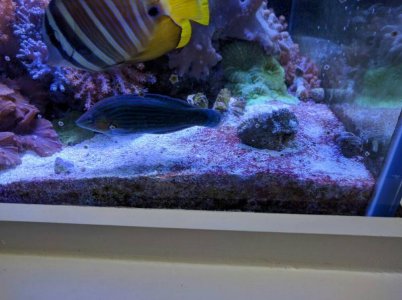I have a 180g DT with about 200lbs of LR. The sump is a 40g that consists of refugium with LR and caulerpa, skimmer (RO rated for 300g) dialed in to skim more on the wet side, a light- medium brown skimmate, and a return section with a Echotech Vectra M1 running at max. The DT tank has 2 Vortech MP40s set to different flows throughout the day.
Nitrate levels seem to be controlled (I am consistently around 7ppm) with a 20% monthly water changes. Phosphates on the other hand need to be controlled with GFO, I get them down to about 5ppm and then need to change out the media.
The tank is stocked with the following:
1 - Yellow Tang 3"
1 - Powder Blue Tang 3"
2 - Hippo Tangs 4"
1- Sailfin Tang 4"
1 - Naso Tang 4"
2 - Anthias
2 - Clowns
1 - Banggai Cardinal
1 - Wrase
1 - Radiata Lionfish
3 - Chromis
1 - Blue Damsel 3"
1 - Goby
I have mixed coral (all appear to be growing and doing well).
I feed twice a day. The first feeding is in the AM, they are given Biotope Lifeline Green. The second feeding is in the PM, they are fed PE Mysis rinsed with RODI water. I only feed what they can consume in 2 minutes. I do give them a decent portion considering the stock, but it is all consumed. There is nothing left floating or sinking after the 2 minutes.
I also seem to get maroon/purplish substance on the sand bed. It does not appear to be red slime algae, although I could be wrong. It is on top and on the front of the sand bed ( I can see it from the front of the DT, it goes to the bottom).
Is this normal for the phosphates needing to be controlled by GFO? I was hoping to be able to run the tank without the extra cost. Am I missing anything?
Thanks!
Nitrate levels seem to be controlled (I am consistently around 7ppm) with a 20% monthly water changes. Phosphates on the other hand need to be controlled with GFO, I get them down to about 5ppm and then need to change out the media.
The tank is stocked with the following:
1 - Yellow Tang 3"
1 - Powder Blue Tang 3"
2 - Hippo Tangs 4"
1- Sailfin Tang 4"
1 - Naso Tang 4"
2 - Anthias
2 - Clowns
1 - Banggai Cardinal
1 - Wrase
1 - Radiata Lionfish
3 - Chromis
1 - Blue Damsel 3"
1 - Goby
I have mixed coral (all appear to be growing and doing well).
I feed twice a day. The first feeding is in the AM, they are given Biotope Lifeline Green. The second feeding is in the PM, they are fed PE Mysis rinsed with RODI water. I only feed what they can consume in 2 minutes. I do give them a decent portion considering the stock, but it is all consumed. There is nothing left floating or sinking after the 2 minutes.
I also seem to get maroon/purplish substance on the sand bed. It does not appear to be red slime algae, although I could be wrong. It is on top and on the front of the sand bed ( I can see it from the front of the DT, it goes to the bottom).
Is this normal for the phosphates needing to be controlled by GFO? I was hoping to be able to run the tank without the extra cost. Am I missing anything?
Thanks!

